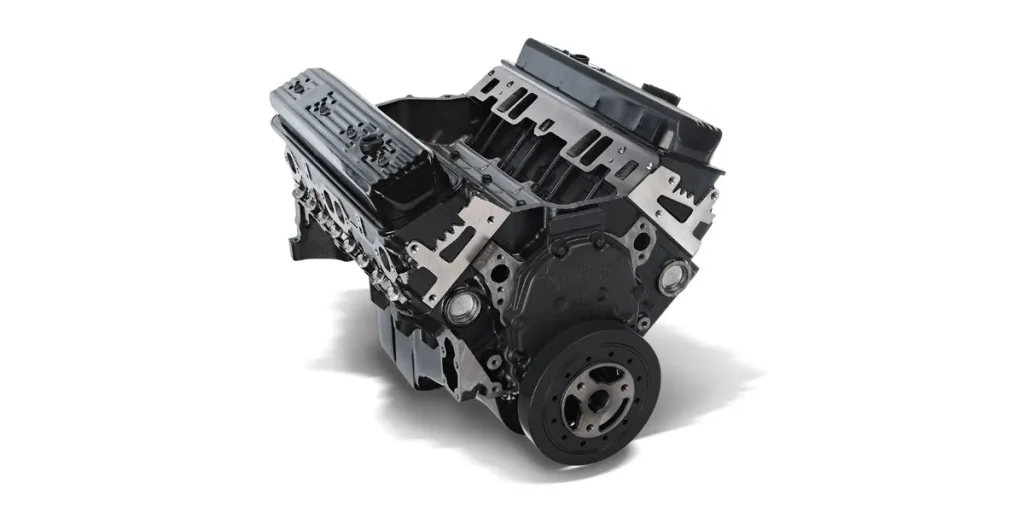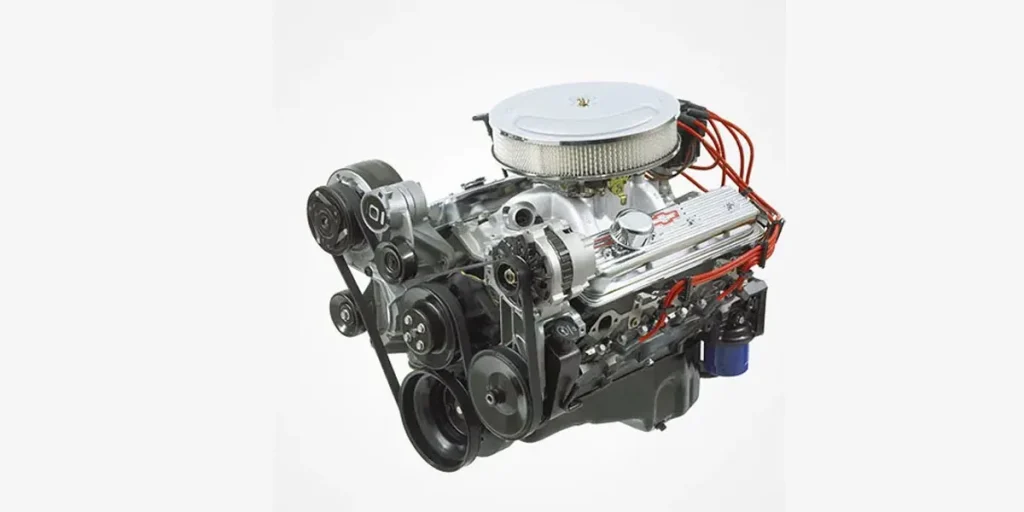An SBC 350 engine typically weighs about 575 pounds (260 kg). This figure can vary slightly depending on the specific components used.
The Chevy Small Block 350, one of the most popular and enduring V8 engines ever produced, is a cornerstone of the American automotive landscape.
Designed for performance and reliability, this engine offers a balance of power and versatility.
Enthusiasts and mechanics alike appreciate the SBC 350 for its simplicity and aftermarket support.
Whether you’re restoring a classic car or building a race engine, understanding the weight of the SBC 350 is critical for any project planning.
It influences factors such as handling, weight distribution, and chassis requirements. Knowing the exact weight ensures proper modifications and supports optimal performance outcomes for car enthusiasts.
The Sbc 350 Legacy

The small block Chevy (SBC) 350 is a legend in automotive lore. It captures the heart of car enthusiasts with a blend of power, reliability, and versatility.
A staple under the hoods of countless cars and trucks, it has left an indelible mark on the fabric of American muscle and performance vehicles.
Origins Of The Small Block Chevy
In 1955, Chevrolet introduced a V8 engine that revolutionized the automotive industry. This lightweight, compact power plant had an initial displacement of 265 cubic inches.
Yet, it was destined for greatness. Sporting an innovative overhead valve design, the small block Chevy was easier and more economical to build than its contemporaries, which helped Chevrolet cars offer both performance and affordability.
Evolution Through The Decades
As years rolled by, the SBC underwent numerous transformations. Chevy consistently increased the displacement, improving performance and efficiency along the way.
By the late 1960s, the 350 cubic inch version emerged as a powerhouse, revered by gearheads across the globe.
It became a choice engine for street machines, hot rods, and even boats. Each era welcomed variants of the SBC 350, from carbureted classics to fuel-injected modern powerhouses, illustrating engineering innovation.
- 1967: The 350 makes its debut in the Chevy Camaro.
- 1970s: Power peaks as muscle cars flourish.
- 1980s: Fuel injection enhances the 350’s efficiency.
- 1990s: The LT1 version powers high-performance vehicles.
- 2000s: The LS1 and its successors dominate the performance scene.
Physical Characteristics Of The SBC 350

The Chevy Small Block 350 stands as a benchmark in automotive engineering.
Known for its balance between power and weight, this engine has a reputation that spans decades.
The physical traits of the SBC 350 help it achieve this legendary status.
Let’s explore the formative aspects of this classic powerhouse.
Dimensions And Design
Essential to understanding any engine is grasping its design and size.
The SBC 350 is no exception.
Its dimensions contribute greatly to its versatility and application across various vehicle models.
- Length: Approximately 28 inches
- Width: Around 24 inches
- Height: Close to 27 inches
Compact yet robust, the SBC 350’s design maximizes engine bay space.
Engineers crafted it for easy fitment in a wide range of cars and trucks.
Its V8 configuration is central to its power delivery profile.
Materials And Manufacturing Process
The SBC 350 owes much of its weight to the materials used and its construction methods.
Cast iron remains the primary material for its block and heads.
The use of aluminum in some models offers weight savings, enhancing performance.
| Type of Material | Weight Impact |
|---|---|
| Cast Iron Block | Heavier, More Durable |
| Aluminum Heads | Lighter, Better Heat Dissipation |
Durability stems from the precision casting methods employed during its manufacture.
These processes ensure each SBC 350 is both strong and reliable.
From the foundry to final assembly, quality control is strict, allowing these engines to last for many years.
Weighing The SBC 350 Engine
Enthusiasts and mechanics alike often ponder the heft of the iconic SBC 350 engine. Understanding its weight is crucial when planning vehicle modifications or engine swaps.
Let’s delve into the specifics and factors that contribute to the weight of a Chevrolet Small Block 350 engine.
Standard Engine Weight
The SBC 350 engine, known for its durability and power, tips the scales at approximately 575 pounds (260kg). This figure represents a fully assembled engine, with all necessary components attached.
Factors Affecting Weight
Different elements can influence the overall weight of the SBC 350 engine:
- Materials: The use of aluminum or cast iron affects engine mass.
- Add-ons: Starter, exhaust manifolds and other accessories add weight.
- Internals: Crankshaft, pistons, and rods can vary in material and design.
Comparative Analysis
Welcome to our comparative analysis where we dive into the specifics of engine weights.
Understanding how much an SBC 350 weighs gives insight into its performance and how it stacks up against the competition.
Sbc 350 Vs. Other Engine Weights
The Small Block Chevy (SBC) 350 is a classic powerhouse beloved by auto enthusiasts. Its weight significantly affects vehicle dynamics and customization choices.
Here’s a brief comparison of the SBC 350’s weight with other popular engines:
- Chevy Big Block: Heavier, usually exceeding the SBC 350 by 100-150 lbs.
- Ford 302: Comparable, but often a tad lighter than the SBC 350.
- Honda B-Series: Much lighter, designed for smaller, compact vehicles.
For ease, let’s look at the weight differences in a table format.
| Engine Type | Approximate Weight |
|---|---|
| SBC 350 | 575 lbs |
| Chevy Big Block | 685 lbs |
| Ford 302 | 460 lbs |
| Honda B-Series | 350 lbs |
Impact Of Weight On Performance
A lighter engine might mean quicker acceleration and better fuel economy. On the other hand, a heavier engine often equates to a more raw power output.
The SBC 350 offers a balance between the two, pairing respectable weight with ample power. Performance impacts due to weight differences include:
- Acceleration: Lighter engines can speed up faster.
- Handling: A heavier front end can affect steering and cornering.
- Fuel Efficiency: Weight has a direct role in how much fuel a car will consume.
In the race for optimized performance, every pound matters. The SBC 350 remains a favored choice due to its remarkable weight-to-power ratio.
Handling And Transportation
The SBC 350 engine, a powerhouse for many classic vehicles, presents certain challenges during handling and transportation.
Weighing in at around 575 pounds, proper equipment and techniques are essential for safe movement. This section delves into the vital aspects of transporting an SBC 350.
Safely Moving An Sbc 350
- Use a high-quality engine hoist with a capacity of at least 1000 pounds.
- Secure the engine with chains or straps at designated lift points.
- Ensure the path is clear to avoid tripping hazards.
- Wear safety gloves and boots while moving the engine.
- A leveling bar may be needed to keep the engine horizontal.
Installation Considerations
- Verify the vehicle support – It must endure the engine’s weight.
- Align the engine meticulously to avoid damage to components.
- Use the right mounting hardware for the SBC 350.
- Double-check the torque specs on all fasteners.
- Having a second person can simplify the installation.
Enhancements And Modifications
Car enthusiasts love tweaking their vehicles. The classic SBC 350 engine is perfect for this. You can change parts or reduce its weight.
These changes affect how much your engine weighs. Let’s dive into the world of enhancements and modifications.
Aftermarket Parts That Affect Weight
Swapping parts can change an engine’s weight. Many choose lightweight materials for better performance. Here are some popular part changes:
- Aluminum Heads: Lighter than iron, improve horsepower.
- Intake Manifold: Aluminum ones weigh less, boost efficiency.
- Flywheels: Switching to aluminum sheds pounds.
- Water Pumps: High-flow versions are lighter, enhance cooling.
- Brackets: Aftermarket options are often lighter.
Weight Reduction Techniques
There are methods to reduce engine weight without new parts. Lightweight metals and composites trim ounces. Here’s how to slim down your SBC 350 engine:
- Lightening Holes: Drill out non-essential areas of metal components.
- Sanding: Remove material from internal engine parts carefully.
- Balancing: Even out weight distribution for efficiency.
- Composite Materials: Opt for carbon fiber or fiberglass where possible.
FAQ About the Weight of an SBC 350
What Is The Weight Of A SBC 350 Engine?
The weight of a Small Block Chevy (SBC) 350 engine is approximately 575 pounds (261 kg) when fully assembled with standard components.
Can SBC 350 Weights Vary By Model?
Yes, Sbc 350 weights can vary depending on the engine accessories, materials used (such as aluminum or iron heads), and specific model variations.
What Factors Contribute To SBC 350 Engine Weight?
The Sbc 350 engine weight is influenced by the cast iron block and heads, intake manifold, carburetor, and additional accessories like the water pump and distributor.
Does The SBC 350 Weight Include Transmission?
No, the Sbc 350 weight typically references the engine alone without the transmission. The transmission weight is calculated separately.
Conclusion
Wrapping up, the SBC 350’s weight is a crucial spec for engine enthusiasts and auto technicians.
Typically tipping the scales at about 575 pounds, understanding this factor is essential when planning installations or modifications.
Keep this figure in mind to ensure your vehicle’s performance and safety align seamlessly.
